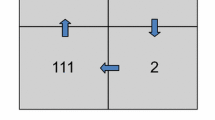Summary
This paper addresses the question of whether a simple two-stage account of variability in timing developed for single-hand repetitive tapping is applicable to regular tapping with the hands in alternation. The task required key presses at a steady rate, previously set by a periodic auditory signal. On separate blocks of trials four subjects used the index finger of the left hand or of the right hand at intervals of 200, 400, and 800 ms or alternated between the hands at intervals of 100, 200, or 400 ms. For each subject the variability of the between-hand intervals in the 200- and 400-ms alternate-hand conditions was greater than the variability of the same interval in the single-hand conditions. In the 100-ms alternate-hand condition correlations between adjacent (between-hand) intervals were reliably less then −.5. These results are inconsistent with the simple two-stage model, and two variants are shown to provide a better qualitative fit to at least some aspects of the data.
Similar content being viewed by others
References
Gentner, D. R. (1983). Keystroke timing in transcription typing. In W. E. Cooper (Ed.), Cognitive aspects of skilled typewriting. Berlin, Heidelberg, New York: Springer.
Haken, H., Kelso, J. A. S., & Bunz, H. (1985). A theoretical model of phase transitions in human hand movements. Biological Cybernetics, 51, 347–356.
Keele, S., Ivry, R. I., & Pokorny, R. A. (1987). Force control and its relation to timing. Journal of Motor Behavior, 19, 96–114.
Kelso, J. A. S. (1981). On the oscillatory basis of movement. Bulletin of the Psychonomic Society, 18, 63.
Kelso, J. A. S. (1984). Phase transitions and critical behavior in human bimanual coordination. American Journal of Physiology: Reg. Integ. Comp. 15, R1000–R1004.
Shaffer, L. H. (1978). Timing in the motor programming of typing. Quarterly Journal of Experimental Psychology, 30, 333–345.
Shaffer, L. H. (1982). Rhythm and timing in skill. Psychological Review, 89, 109–122.
Turvey, M. T., Rosenblum, L. D., Kugler, P. N., & Schmidt, R. C. (1986). Fluctuations and phase symmetry in coordinated rhythmic movements. Journal of Experimental Psychology: Human Perception and Performance, 12, 564–583.
Vorberg, D., & Hambuch, R. (1984). Timing of two-handed rhythmic performance. Annals of the New York Academy of Sciences, 423, 390–406.
Wing, A. M., & Kristofferson, A. B. (1973). Response delays and the timing of discrete motor responses. Perception & Psychophysics, 14, 5–12.
Wing, A. M. (1977a). Effects of type of movement on the temporal precision of response sequences. British Journal of Mathematical and Statistical Psychology, 30, 60–72.
Wing, A. M. (1977b). Perturbations of auditory feedback delay and the timing of movement. Journal of Experimental Psychology: Human Perception and Performance, 3, 175–186.
Wing, A. M. (1979). A note on the estimation of the autocovariance function in the analysis of timing of repetitive responses. British Journal of Mathematical and Statistical Psychology, 32, 143–145.
Wing, A. M. (1980). The long and short of timing in response sequences. In G. E. Stelmach & J. Requin (Eds.), Tutorials in motor behaviour. Amsterdam: North Holland.
Wing, A. M. (1982). Timing and co-ordination of repetitive bimanual movements. Quarterly Journal of Experimental Psychology, 34A, 339–348.
Yamanishi, J., Kawato, M., & Suzuki, R. (1980). Two coupled oscillators as a model for the coordinated finger tapping by both hands. Biological Cybernetics, 37, 219–225.
Author information
Authors and Affiliations
Rights and permissions
About this article
Cite this article
Wing, A.M., Church, R.M. & Gentner, D.R. Variability in the timing of responses during repetitive tapping with alternate hands. Psychol Res 51, 28–37 (1989). https://doi.org/10.1007/BF00309273
Received:
Issue Date:
DOI: https://doi.org/10.1007/BF00309273




